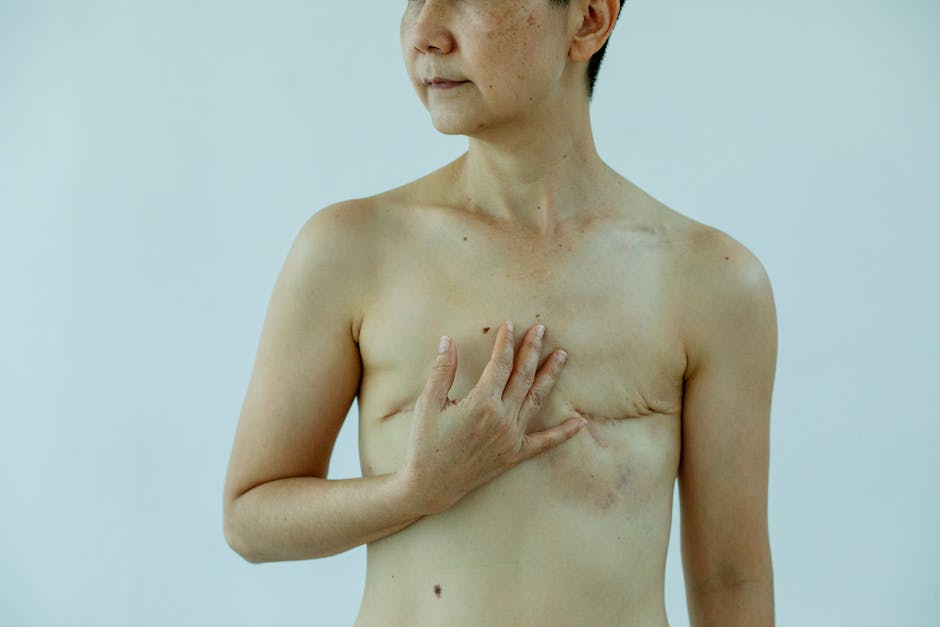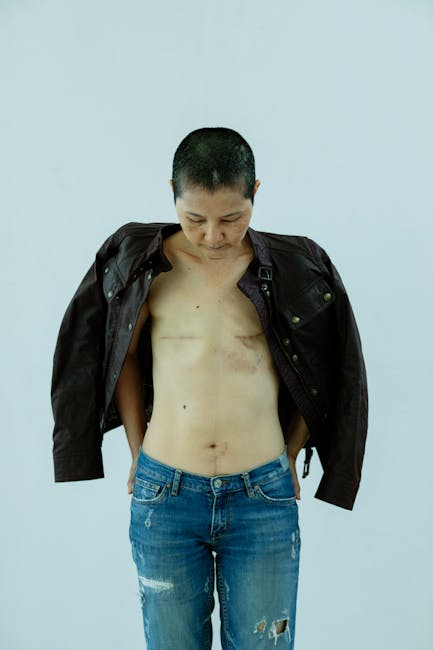Understanding Breast Cancer: Symptoms, Risk Factors, and Treatment Options
Overview of Breast Cancer

Overview of Breast Cancer
Breast cancer is a prevalent form of cancer that develops in the breast tissue, affecting both women and men, with symptoms ranging from lumps and changes in breast shape to nipple discharge and skin dimpling.
Understanding Breast Cancer and its prevalence
Breast cancer is a prevalent form of cancer that develops in the breast tissue, affecting both women and men, with symptoms ranging from lumps and changes in breast shape to nipple discharge and skin dimpling. Understanding breast cancer and its prevalence is crucial for early detection and effective treatment.
Common Symptoms of Breast Cancer

Common Symptoms of Breast Cancer:
1. Presence of a lump or thickening in the breast or underarm.
2. Changes in breast size, shape, or appearance.
3. Nipple discharge or inversion.
4. Skin changes, such as redness, dimpling, or puckering.
5. Persistent pain or tenderness in the breast or nipple area.
Remember to consult a healthcare professional if you experience any of these symptoms for further evaluation and diagnosis.
Risk Factors for Breast Cancer
Genetic factors and family history play a significant role in the risk of developing breast cancer, while lifestyle factors and environmental exposures can also increase the likelihood of developing the disease. It is important to be aware of these risk factors and take necessary precautions for early detection and prevention.
Genetic Factors and Family History

- Family history of breast cancer, especially if a first-degree relative has been diagnosed, can also elevate the risk.
- It is important for individuals with a family history of breast cancer to consider genetic counseling and testing to assess their personal risk.
- If a genetic mutation is detected, preventive measures such as increased screening or prophylactic surgery may be recommended.
- Additionally, individuals with certain gene mutations may be eligible for targeted therapies or clinical trials.
- Understanding and addressing genetic factors and family history can help in early detection and prevention of breast cancer.
Lifestyle Factors and Environmental Exposures

Lifestyle Factors and Environmental Exposures
- Adopting a healthy lifestyle, including regular exercise and a balanced diet, can reduce the risk of breast cancer.
- Avoiding exposure to environmental factors like tobacco smoke, radiation, and certain chemicals can also play a role in prevention.
- Maintaining a healthy weight, limiting alcohol consumption, and breastfeeding can further lower the risk.
- It is important to be aware of these lifestyle factors and take proactive steps to reduce the risk of breast cancer.
Diagnosis and Staging of Breast Cancer

Diagnosis and Staging of Breast Cancer
- Breast cancer diagnosis involves imaging tests, biopsies, and laboratory tests to determine the presence and characteristics of cancer cells.
- Staging helps determine the extent of cancer spread and guides treatment decisions.
- Stages range from 0 to IV, with lower stages indicating localized cancer and higher stages indicating more advanced disease.
- Imaging tests such as mammograms, ultrasounds, and MRIs help assess the size, location, and spread of tumors.
- Biopsies, including needle biopsy and surgical biopsy, provide tissue samples for laboratory analysis.
- Laboratory tests, including hormone receptor testing and genetic testing, help identify specific characteristics of the tumor and inform treatment options.
- Accurate diagnosis and staging are crucial for developing an effective treatment plan for breast cancer patients.
Breast Cancer Screening Methods
Breast cancer screening methods include mammograms, clinical breast exams, and self-exams, which help detect abnormalities and potential signs of cancer.
Stages of Breast Cancer and Prognosis
Breast cancer has different stages that help determine the extent of the disease and guide treatment decisions, with prognosis varying based on the stage.
Here are the stages of breast cancer:
- Stage 0: Non-invasive cancer cells are confined to the ducts or lobules.
- Stage 1: Cancer is small and localized, not spreading to lymph nodes.
- Stage 2: Cancer may be larger or involve nearby lymph nodes.
- Stage 3: Cancer has spread to lymph nodes and surrounding tissues.
- Stage 4: Cancer has metastasized to distant organs like the lungs or bones.
Prognosis depends on factors like tumor size, lymph node involvement, and presence of hormone receptors. Treatment options will be tailored accordingly.
Table:
| Stage | Description |
|---|---|
| 0 | Non-invasive cancer cells confined to ducts or lobules |
| 1 | Small, localized cancer without lymph node involvement |
| 2 | Larger tumor or lymph node involvement |
| 3 | Cancer spread to nearby tissues and lymph nodes |
| 4 | Metastatic cancer that has spread to distant organs |
Remember, early detection through regular screenings increases the chances of successful treatment and improved outcomes.
Treatment Options for Breast Cancer
Treatment options for breast cancer include surgery, chemotherapy, radiation therapy, hormone therapy, and targeted therapy. These treatments may be used alone or in combination depending on the stage and characteristics of the cancer.
Surgery, Chemotherapy, and Radiation Therapy
Surgery, chemotherapy, and radiation therapy are common treatment options for breast cancer.
Surgery involves the removal of the tumor and may include a lumpectomy or mastectomy.
Chemotherapy uses drugs to kill cancer cells and may be administered before or after surgery.
Radiation therapy uses high-energy beams to target and destroy cancer cells in the breast area.
Hormone Therapy and Targeted Therapy
Hormone therapy is a common treatment for hormone receptor-positive breast cancer and aims to block the effects of estrogen or progesterone on cancer cells. Targeted therapy, on the other hand, targets specific genes or proteins involved in the growth and survival of cancer cells.
Survivorship and Support

After completing breast cancer treatment, survivorship and support are crucial.
- Embrace life after treatment by focusing on physical and emotional healing.
- Seek out supportive care programs that provide resources for post-treatment challenges.
- Connect with other survivors to share experiences and find a sense of community.
- Take advantage of survivorship programs that offer educational resources and guidance on long-term health and well-being.
- Prioritize self-care through healthy lifestyle choices, including a balanced diet and regular exercise.
Remember, survivorship is a journey, and with the right support, you can navigate it successfully.
Life after Breast Cancer Treatment
Embrace life after treatment by focusing on physical and emotional healing. Seek out supportive care programs that provide resources for post-treatment challenges. Connect with other survivors to share experiences and find a sense of community. Take advantage of survivorship programs that offer educational resources and guidance on long-term health and well-being. Prioritize self-care through healthy lifestyle choices, including a balanced diet and regular exercise. Remember, survivorship is a journey, and with the right support, you can navigate it successfully.
Supportive Care and Survivorship Programs
Supportive care and survivorship programs offer resources for post-treatment challenges, such as physical and emotional healing. Connect with other survivors for a sense of community and access educational resources for long-term health and well-being.
Conclusion
Conclusion:
- Early detection and treatment are crucial in improving breast cancer outcomes.
- Resources for breast cancer patients and survivors, such as support groups and survivorship programs, can provide valuable support and education.
- Stay proactive in managing your health with regular screenings and follow-up appointments.
- Advocate for yourself and seek second opinions to ensure the best possible care.
- Remember that you are not alone – there is a strong community of survivors ready to support you on your journey.
Importance of Early Detection and Treatment
Early detection and treatment of breast cancer is crucial as it improves outcomes. Be proactive by getting regular screenings and follow-up appointments. Seek second opinions to ensure the best possible care. Remember, you are not alone - there is a strong community of survivors ready to support you on your journey.
Resources for Breast Cancer Patients and Survivors
- Join support groups and online communities to connect with others who have gone through similar experiences.
- Seek out educational resources and reliable websites for information on breast cancer treatment, survivorship, and self-care.
- Utilize counseling services to address emotional and psychological needs during and after treatment.
- Explore complementary therapies like acupuncture or yoga to manage side effects and promote well-being.
- Take advantage of survivorship programs offered by hospitals and organizations to navigate life after breast cancer.
Remember, you are not alone in your journey, and there are numerous resources available to support you through every step of the way.

Comments
Post a Comment